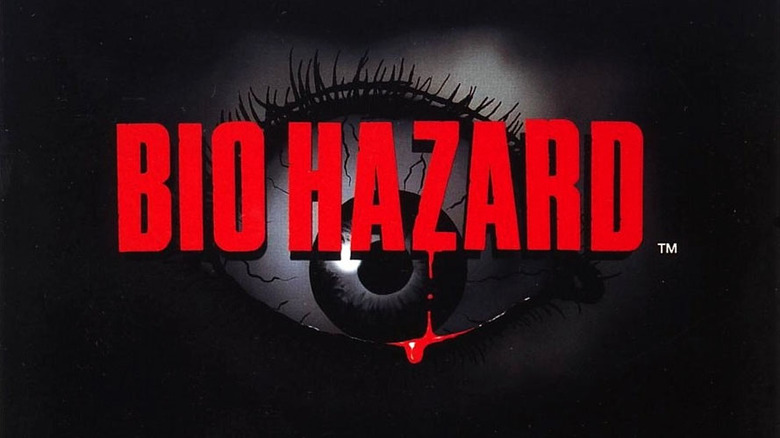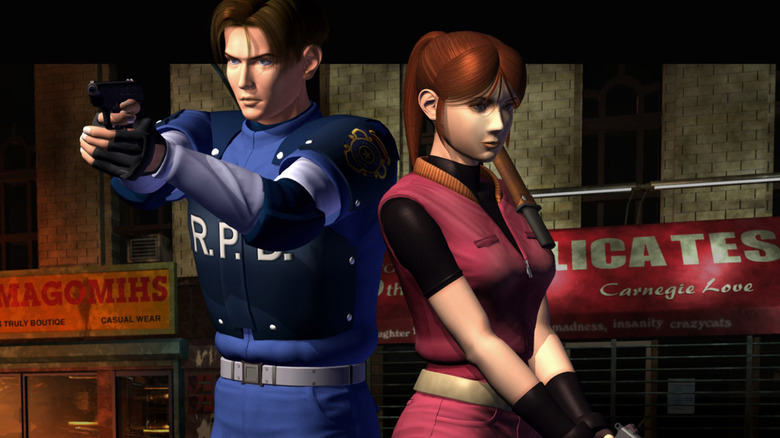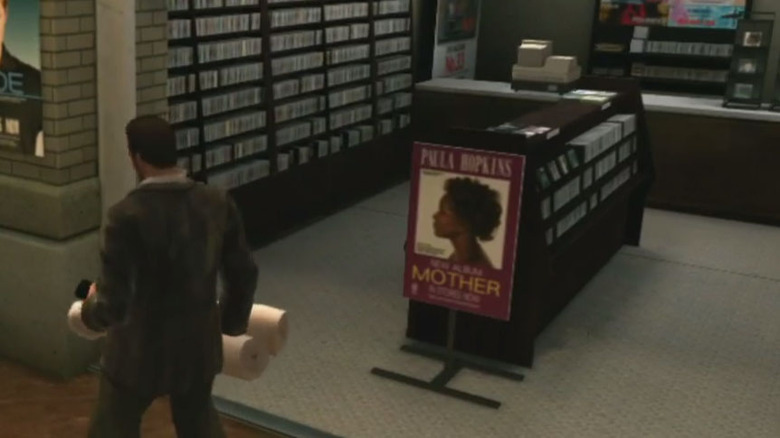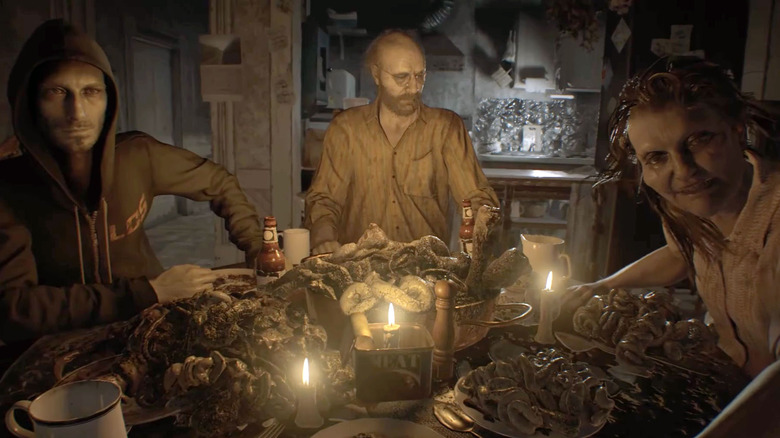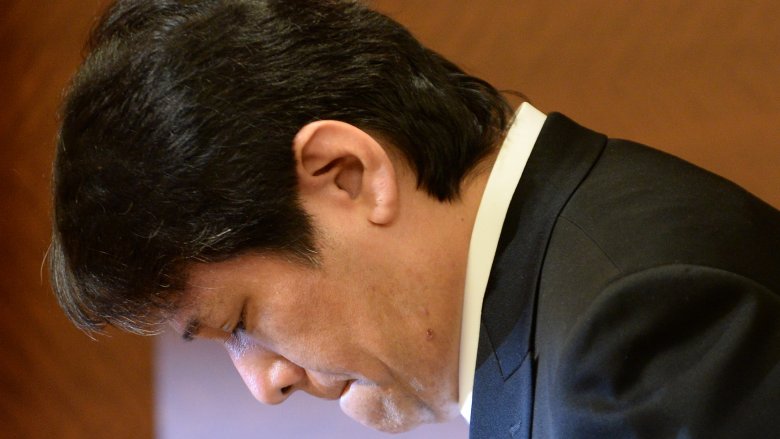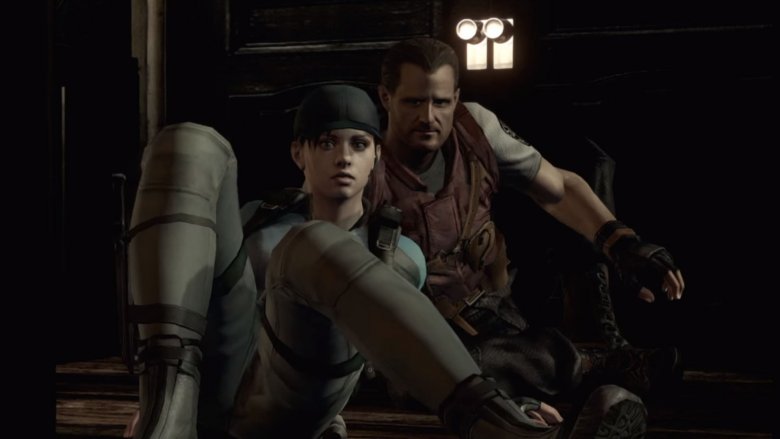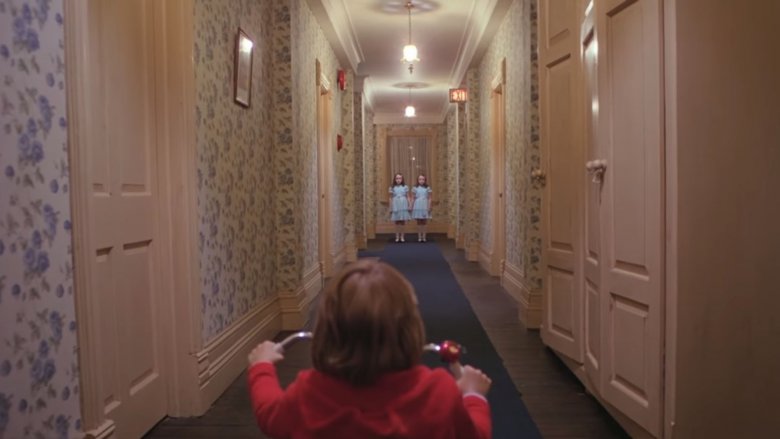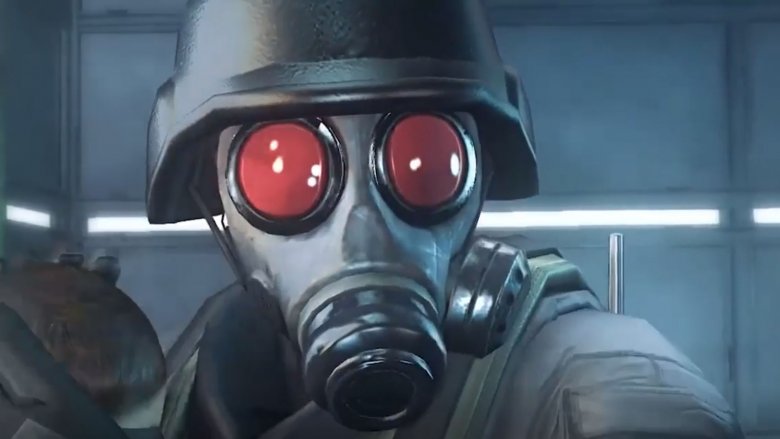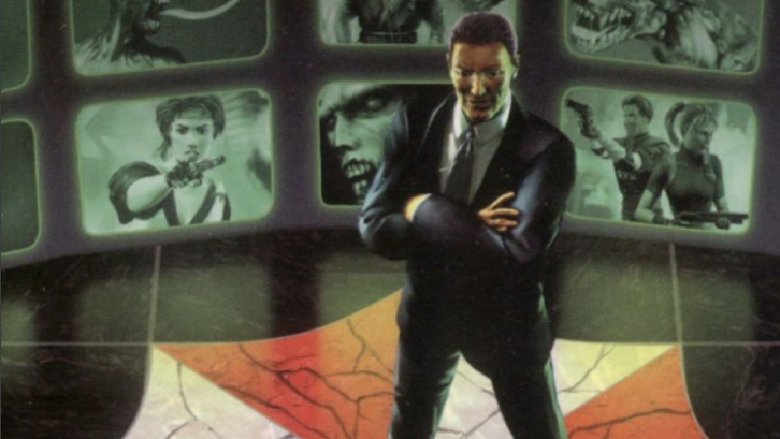The Untold Truth Of Resident Evil
It's a good time to be a Resident Evil fan. Resident Evil 7 restored the franchise's glory by returning to its survival horror roots, Resident Evil: The Final Chapter is the best-reviewed entry in the long-running film series, and if the cinematic adaptations weren't your cup of tea, then we have some good news: now that Milla Jovovich's run is over, director James Wan (Saw, Furious 7) is rebooting the whole thing.
But getting here hasn't been easy: over the past two decades, the history of the Resident Evil franchise has taken a number of odd twists and turns. Numerous titles entered production, and few ever saw the light of day. The series endured criticism from both concerned parents and federal courts. Fans complained. But like one of its undead foes, Resident Evil just won't stay down. Thank goodness.
Resident Evil started as a Sweet Home remake
You probably haven't heard of Sweet Home. That's okay. The 1989 Famicom game, based on a horror film of the same name, never made it out of Japan. Still, you've enjoyed many of the game's more popular tropes. See, Resident Evil started as a remake (or, possibly, sequel) to Sweet Home, and many of the game's standard features made their way into its more famous younger sibling.
In Sweet Home, a group of five filmmakers invade a haunted house in order to rescue some rare art. The similarities are clear from the get-go. Like Resident Evil, Sweet Home has multiple characters—although unlike Chris Redfield and Jill Valentine, who adventure separately, Sweet Home asks players to manage the entire party at once. Both games take place in giant mansions. Resident Evil's punishing inventory system, which forces players to carefully consider how they use their resources, is a direct copy of Sweet Home's. Even Resident Evil's infamous door-opening animations, which play while the PlayStation loads new environments, came from similar transitions in Sweet Home.
None of that is an accident. In 1993, Sweet Home director Tokuro Fujiwara called Shinji Mikami, the man behind the Aladdin and Goof Troop video game adaptations, into his office. "He said that he wanted us to make a horror game using systems from Sweet Home," Mikami recalled, admitting he was worried about how well the title would sell—while many games used horror movie iconography, real horror games hadn't ever caught on—but enthusiastically went to work anyway. He shouldn't have been concerned: Capcom moved almost three million copies of Resident Evil, and a new hit was born.
Capcom held a contest to name the series
In Japan, Resident Evil is known as Biohazard, which has been the name of the franchise since the first game launched in 1996. That wasn't going to fly in the United States, where "biohazard" is a common word (not to mention the title of numerous games and the name of a well-known heavy metal band). If Capcom wanted to trademark the title, they'd need a new name.
So the company held a contest, and executives asked employees to come up with potential names for the new series. According to Capcom US senior director of communications and community Chris Kramer, the marketing team got tons of entries, and picked Resident Evil, which was submitted by one of the company's game designers. "It was a clever pun," Kramer explains. "The first game was set in a mansion, get it?"
For his part, Kramer didn't particularly like the title, and voted against it, saying he "thought it was super-cheesy." But the rest of marketing and the higher-ups back in Japan loved it, so Resident Evil stuck. For his part, Kramer admitted that his suggestion probably wasn't much better. "Can't remember what I felt was a better alternative," he said. "Probably something stupid about zombies."
In American courts, the game is known as Resident of Evil Creek
It's pretty safe to say that Stephen N. Limbaugh Sr., a federal judge, isn't much of a gamer. Not only did he get the names of two of the most popular series in gaming wrong in an official court statement, but he also ruled that, after reviewing four different games, "this court... found no conveyance of ideas, expression, or anything else that could possibly amount to speech." By "speech," he means the kind that's free and protected under the First Amendment. Yeah. Ouch.
The decision came during a 2002 case during which the Interactive Digital Software Association took St. Louis County to court over a local ordinance that required anyone under the age of 17 to receive parental consent before playing violent or sexual video games. The IDSA claimed that the law violated the First Amendment. St. Louis—and Limbaugh—disagreed. Limbaugh admitted that games have backstories, settings, plots, dialogue, and other narrative content, but argued that "video games have more in common with board games and sports than they do with motion pictures." As such, they're not protected by the Constitution.
Of course, given that Limbaugh couldn't even get the names of two of the four games right, the entire ruling is suspect. The court opinion calls one game Resident of Evil Creek. Another is referred to as Mortal Combat (as fighting game fans know, "Kombat" is spelled with a K). Besides that, in 2002, a separate 7th Circuit Court case—which both predated and outranked Limbaugh's decision— had already classified video games as free speech, rendering Limbaugh's verdict more or less worthless. The only thing it really produced? A hilarious nickname for one of gaming's most resilient and long-lived franchises. Thanks, Judge Limbaugh!
Resident Evil 2 was supposed to be the end of the series
Resident Evil 4, which put federal agent Leon Kennedy up against swarms of parasites known as the plaga, revolutionized action games. Resident Evil 7 breathed new life into the flagging survival horror genre, moving Resident Evil into first-person for the first time. And yet, if Capcom had stuck with series creator Shinji Mikami's original plan, neither would've ever happened.
Resident Evil 2 underwent a long and grueling development process, and as its 1997 release date loomed closer, Mikami realized the game wasn't going to meet his or Capcom's standards. And so, with the game somewhere between 60 and 80 percent finished, Capcom threw out the entire thing and started over.
That gave Capcom a chance to bring screenwriter Noboru Sugimura on board to fix Resident Evil 2's story, which producer Yoshiki Okamoto didn't like. Allegedly, Mikami wanted Resident Evil 2 to wrap up the plot and serve as the series finale. Okamoto wanted a franchise that could run forever, like Gundam or James Bond. Sugimura glommed on to Okamoto's vision, and re-wrote pretty much the entire game. That's probably for the best, at least as far as Capcom's bottom line is concerned: over the years, the publisher has sold over 71 million Resident Evil games, and it doesn't look like the series is slowing down anytime soon.
Resident Evil 2's cinematics were created using action figures
If you think you're too old to play with toys, think again. While Resident Evil 2's pre-rendered cutscenes may not have aged well, in 1998 they were cutting edge, and they never would've happened if the folks at Capcom hadn't gotten down and dirty with a bunch of action figures.
Resident Evil began and ended with live-action cutscenes filmed using living actors, so it isn't a stretch to assume that Resident Evil 2 used real people to bring Raccoon City and its various locales to life. Apparently, that isn't the case: 1998's Resident Evil: The Comic Book Magazine #3 features an exclusive interview with creator Shinji Mikami that, while light on specifics and heavy on praise (it's an officially licensed publication, after all), reveals details of the production. "First, using motion pictures and action figures, we made image videos [shots of the figures from every angle] to get standard images," Mikami explained. "Then, we used CG tools to render each picture and convert the data for PlayStation."
That's vague, but it sounds like Capcom used toys to create special animatics—or an animated storyboards—for Resident Evil 2's cutscenes, and then gave those to the animators to use as a guide (other people interpreted this statement to mean that Capcom actually animated the figures using stop-motion animation techniques, but given how time-consuming that process is, it seems unlikely).
Devil May Cry started out as Resident Evil 4
Resident Evil 4 represents a big shift for the franchise. While the first three Resident Evil titles (and their prequel, Resident Evil 0) were horror survival games that rewarded patience, caution, and careful inventory management, RE 4 moved the series into action territory. Leon, Resident Evil 4's hero, is faster and more coordinated than his predecessors. Instead of simply shooting straight ahead or up and down, players can target enemies' specific body parts, which react to wounds differently. Resident Evil 4 focuses more on combat than puzzles, and comes with context-sensitive "finishing moves" that let Leon decimate his foes in creative, gory fashion.
And yet, while Resident Evil 4 is a departure, it could've been even more different. When originally charged with creating the next installment in the franchise, Resident Evil 2 director Kamiya Hideki and writer Noboru Sugimura decided to make a slick and stylish action game, with "cool" serving as the underlying design sense. The hero they created was an "an invulnerable man with ability exceeding human knowledge." Like previous Resident Evil games, biotechnology played a big role in the plot, but so did medieval and Gothic-style architecture.
Ultimately, series producer Shinji Mikami decided that the new direction took the game too far from Resident Evil's roots. Instead of canning the project, however, Mikami convinced Capcom's executives to make the in-progress Resident Evil 4 its own title. Hideki transformed the hero from a sci-fi superhuman into a demon-powered warrior, christened him Dante, and voila! Devil May Cry was born.
Dead Rising and Resident Evil might take place in the same universe
This might just be an Easter egg, but either way, it's worth mentioning. Experienced Dead Rising players will recognize the fictional musician Paula Hopkins, whose album, Mother, is all over the music store in the Willamette Parkview Mall. Stand-up displays celebrate Mother's recent release. Whenever Frank West, Dead Rising's protagonist, grabs a stack of CDs, Paula Hopkins' latest is right on top.
Guess who shows up in Resident Evil 5? Early in the game—in stage 1-2, to be specific—eagle-eyed players might spot a Paula Hopkins poster hanging on the wall, promoting the Mother album. Now, given that both Resident Evil and Dead Rising are Capcom productions, the likeliest explanation is that the company is just having a little bit of fun—but think about it. Both games focus on zombie outbreaks. It isn't completely ludicrous to assume that there's some connection between the two. On the other hand, a comic shop in Dead Rising 4 is stocked with Resident Evil comic books, implying that the game series is fictional in the Dead Rising universe, too. Unless someone at Capcom speaks up, we'll never know for sure.
Fans hacked Resident Evil 5's leaderboards to send Capcom a message
If you haven't noticed, Resident Evil games tend to go through lengthy, complicated development cycles with many dead ends. As a result, there are a handful of near-complete Resident Evil games out there that people never got to play. There's the first pass at Resident Evil 2, which fans call Resident Evil 1.5. There's the ugly but surprisingly complete Game Boy Color edition of the PlayStation's original Resident Evil. There are at least three different Resident Evil 4 prototypes that were exposed to the public during the game's production.
It doesn't matter that most of these games were never finished. Dedicated fans want to play all of them. In the absence of an official release, some amateur developers took matters into their own hands: people are working hard to restore both Resident Evil 1.5 and the "hook man" version of Resident Evil 4. For others, however, that's not good enough. They want an official release.
They let Capcom know, too. See, Resident Evil 5 includes a competitive mode called "Mercenaries," in which players have two minutes to kill zombies and amass as many points as possible. A global leaderboard tracks the top scores from around the world. When players figured out how to hack the board and post the highest possible scores, what did they do? They used the platform to deliver Capcom an ultimatum: "Release RE1dot5. We were waiting [for] it for 15 years." Crude, but it certainly gets the point across.
Milla Jovovich's character is never named in the first Resident Evil movie
Resident Evil is the highest-grossing feature film franchise based on a video game, but the series is only loosely based on the games that inspired it. Many of the characters are the same, and the films are full of visual nods to their console brethren. The tone and style are totally different, however, favoring slick action and high-octane stunts over moody survival horror.
The main character is totally different, too. While the Resident Evil games focus on Chris and Claire Redfield, Leon Kennedy, and Jill Valentine, Milla Jovovich's Alice anchors the Resident Evil movies. It's a big change from the source material, and one that's completely intentional. According to Resident Evil director Paul W.S. Anderson (who helmed the first, fourth, fifth, and sixth entries in the franchise, and produced the other two), Alice is a "blank slate." It doesn't matter if you've played the games or not. Everybody enters the theater on equal footing.
Of course, there's a literal interpretation for "blank slate," too. Alice begins her Resident Evil adventure suffering from amnesia, and doesn't know anything about herself, including her name. The other characters don't have a clue either, and Alice isn't ever named in the film (although "Alice" appears in promotional materials and the movie's official novelization). That's intentional. Anderson wanted to play up Alice's internal struggle with her lack of identity, which helps the audience feel what she's going through (that's the theory, anyway).
Many of the monsters in Resident Evil 7 were sculpted from actual meat
If you thought those fleshy bad guys in Resident Evil 7 looked gross onscreen, just wait until you see what they looked like in real life. In order to make sure the game's army of creepy crawlies looked as realistic as possible, the developers at Capcom used photogrammetry to create 3D models of real-life creations.
If you're not up on your 3D modeling terminology, photogrammetry is a process in which artists build real-life replicas of an object, then take pictures of it from a variety of angles. Next, modelers load those images into a computer and use them to create a stunningly faithful digital reproduction of the original object (photogrammetry is also why the ships and weapons in Star Wars Battlefront looked so accurate—they were scanned from the original props).
For Resident Evil 7, this meant that artists could create various creatures using special effects make-up, and then scan their creations into the computer. For the game's fleshier, squishier, and bloodier monsters, however, they took an extra step and made models out of actual meat. That's right: that goopy monstrosity looks realistic because it's actually been built out of animal flesh. Gross.
We shouldn't be too surprised. Capcom sold meat sculptures (intended to be eaten) that looked like human body parts from a Resident Evil-themed pop-up shop in 2012, ostensibly to benefit the real-life charity the Limbless Association. Of course, it was a pretty good marketing stunt, too.
The deaf Resident Evil composer who wasn't really deaf (or a composer)
You might know Mamoru Samuragochi as the composer who scored Resident Evil: Director's Cut DualShock Ver., which came out in 1998. You might also know him as "Japan's Beethoven," a title he earned after going completely deaf at age 35 thanks to a degenerative disease. Not that he's let losing his hearing slow him, of course. Since going deaf, Samuragochi has scored two video games (Resident Evil and Onimusha), written a symphony dedicated to the victims of Hiroshima, and composed music to benefit earthquake victims. He's been profiled in Time Magazine. He's talented, inspirational ... and a complete fraud.
Samuragochi's most popular music, like the piece that figure skater Daisuke Takahashi used in the 2014 Winter Olympics? He didn't actually write it. Someone else did. In a 2014 interview that rocked the Japanese music world, Samuragochi admitted, "I started hiring the person to compose music for me around 1996." As Samuragochi explained, his deteriorating hearing made his job impossible to do, and "more than half" of Samuragochi's work actually belonged to someone else.
As it turns out, that isn't quite true, either. Oh, Samuragochi had a ghostwriter. He just isn't actually deaf. A day after Samuragochi's confession, Takashi Niigaki, the music school teacher who served as Samuraguchi's "co-conspirator," claimed that Samuragochi simply pretends not to be able to hear (allegedly, he can't read music, either). Even worse, when Niigaki tried to quit, the teacher says, Samuragochi threatened to kill himself.
Samuragochi's story is great, but that's all it is: a story, and nothing more.
The real reason why Resident Evil's voice acting is so terrible
Resident Evil might be a video game, but it sticks pretty closely to its B-movie roots. Too closely, maybe, as far as its dialogue is concerned. Over the years, clunkers like the infamous "You were almost a Jill sandwich!" have become running jokes, and for better or worse, shoddy voice acting is a major part of Resident Evil's legacy.
It's bad, especially for a major video game franchise. So, who's to blame? At a convention in 2014, some of Capcom's staff spilled the beans. At a session titled "Behind the Voices of Capcom Games," a panel revealed that Resident Evil's lackluster vocal performances have nothing to do the actors. It just some good, old-fashioned cultural miscommunication. Resident Evil characters speak English, but the games are made in Japan. As Jonathan Klein, one of Capcom's English-language producers, explains, "The Japanese will always pick what they think sounds good in their minds, not necessarily what sounds good to an English-speaking audience."
D.C. Douglas, who played Albert Wesker in Resident Evil 5, gives an example. Resident Evil's original Wesker, Sergio Jones, is "a good actor," Douglas says. "It sounds horrible because ... you have no idea [about the context of the scene, so you] just keep repeating the line ... and then some Japanese engineer goes, 'I like the rhythm of that last one.'" It might sound good, but it doesn't sound right — and thus, two decades worth of memes are born.
All work and no play makes Wesker a dull boy
For the most part, Resident Evil wears its influences on its sleeve. The early games are a blood-soaked love letter to zombie movie maestro George A. Romero. African adventure Resident Evil 5 borrows liberally from 28 Days Later and the Somalia-set Black Hawk Down. Resident Evil 7 feels a whole lot like The Texas Chainsaw Massacre, with a little bit of Saw thrown in for good measure.
If you like Resident Evil, however, you've really got The Shining to thank. Stanley Kubrick's bone-chilling adaptation of Stephen King's classic novel played a big role in giving the first Resident Evil game it's spooky vibe. See, both The Shining and Resident Evil take place in labyrinthine estates that are crammed full with supernatural weirdness, and Resident Evil director Shinji Mikami liked the contrast between the Overlook Hotel's posh aesthetic and the evil lurking underneath. Allegedly, some of Resident Evil's pre-rendered backdrops were even directly based on The Shining's lavish sets.
The Resident Evil/Shining connection lasted far longer than Mikami's tenure on the series, too. Mikami left the franchise after Resident Evil 4, but it turns out that Resident Evil 7 scenario designer Morimasa Sato is a big Shining fan, too. In fact, you know where Resident Evil 7's door-smashing villain, Jack Baker, gets his name? Why, from The Shining's dual Jacks — actor Jack Nicholson and the character he plays, Jack Torrence.
Even the cops agree: what a HUNK!
If you're going to hunt zombies, you need the right gear. If you're going to pretend to be someone who hunts zombies, you'll need the right pretend gear. Still, the tools that one uses to dispatch the undead hordes aren't always appropriate for other situations, as Jay, a Seattle cosplayer, learned the hard way after his Resident Evil cosplay got him in trouble with local police.
In May 2009, Jay decided to take a break from a local "zombie crawl" and popped into a clothing shop near the Seattle Center while dressed as HUNK, the Umbrella Corporation's faceless, voiceless, zombie-hunting commando. Replica grenades, knives, and machine guns — Jay had it all. That's a good costume, but it's an even better way to scare the straights. Before long, a dozen cop cars converged on the store. Jay was arrested, but the police quickly realized what was going on and set him free shortly thereafter.
Jay doesn't blame the police. "It's definitely understanding," he says. "They weren't aware of the event going on." It's not the only time that Jay's costume got attention that weekend, either. The event's sponsor, Crypticon, gave Jay the prize for best costume, earning him a free ticket to the Crypticon convention the following weekend. That's a little bit of a mixed message, but hey! No matter how you get it, a win's a win.
You probably haven't heard of Resident Evil's real hero
So, you've played all of the Resident Evil games multiple times. You think you've got a good handle on Umbrella Corp, S.T.A.R.S., the T-Virus, Tricell, the Plaga, and all the rest. Well, we've just got one question for you: what do you know about Trent?
That's what we thought. Trent might be one of the most important figures in Resident Evil lore, but if you want to know his story you're going to have to put down the controller and crack open a book. From 1998 through 2004, author S.D. Perry wrote seven officially licensed Resident Evil novels: five based on the video games, and two original stories. Perry's books aren't just simple recaps of what happened on your console, though. They expand the Resident Evil world in all kinds of weird ways — and they put a mysterious figure named Trent right in the middle of everything.
Born Victor Darius, Trent is the son of the two Umbrella Corporation scientists who created the T-Virus, and who Umbrella had killed after their morals got in the way. Victor swore revenge, and his quest for revenge has driven the franchise ever since. It was Victor who rescued Albert Wesker when the Spencer Mansion exploded. It was Victor, going by Trent, who leaked vital information to S.T.A.R.S. and helped Claire Redfield, Jill Valentine, and the rest uncover Umbrella's misdeeds. Very few fans seem to have read Perry's books (and, to be fair, they contradict some of the games' canon), but rest assured, if it happened in Resident Evil? It's almost certainly Trent's fault.

